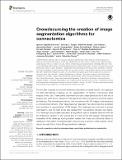Crowdsourcing the creation of image segmentation algorithms for connectomics
Author(s)
Arganda-Carreras, Ignacio; Turaga, Srinivas C.; Berger, Daniel R.; Cireşan, Dan; Giusti, Alessandro; Gambardella, Luca M.; Schmidhuber, Jürgen; Laptev, Dmitry; Dwivedi, Sarvesh; Buhmann, Joachim M.; Liu, Ting; Seyedhosseini, Mojtaba; Tasdizen, Tolga; Kamentsky, Lee; Burget, Radim; Uher, Vaclav; Tan, Xiao; Sun, Changming; Pham, Tuan D.; Bas, Erhan; Uzunbas, Mustafa G.; Cardona, Albert; Schindelin, Johannes; Seung, H. Sebastian; ... Show more Show less
Downloadfnana-09-00142.pdf (3.433Mb)
PUBLISHER_CC
Publisher with Creative Commons License
Creative Commons Attribution
Terms of use
Metadata
Show full item recordAbstract
To stimulate progress in automating the reconstruction of neural circuits, we organized the first international challenge on 2D segmentation of electron microscopic (EM) images of the brain. Participants submitted boundary maps predicted for a test set of images, and were scored based on their agreement with a consensus of human expert annotations. The winning team had no prior experience with EM images, and employed a convolutional network. This “deep learning” approach has since become accepted as a standard for segmentation of EM images. The challenge has continued to accept submissions, and the best so far has resulted from cooperation between two teams. The challenge has probably saturated, as algorithms cannot progress beyond limits set by ambiguities inherent in 2D scoring and the size of the test dataset. Retrospective evaluation of the challenge scoring system reveals that it was not sufficiently robust to variations in the widths of neurite borders. We propose a solution to this problem, which should be useful for a future 3D segmentation challenge.
Date issued
2015-11Department
Institute for Medical Engineering and ScienceJournal
Frontiers in Neuroanatomy
Publisher
Frontiers Media SA
Citation
Arganda-Carreras, Ignacio, et al. “Crowdsourcing the Creation of Image Segmentation Algorithms for Connectomics.” Frontiers in Neuroanatomy, vol. 9, Nov. 2015. © 2015 The Authors
Version: Final published version
ISSN
1662-5129